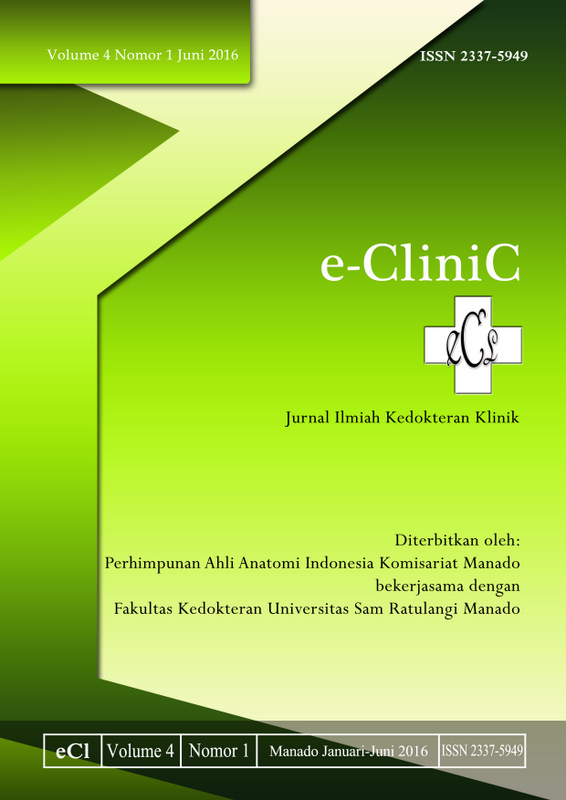HUBUNGAN STATUS GIZI DENGAN TINGKAT KEPADATAN PARASIT MALARIA PADA ANAK
DOI:
https://doi.org/10.35790/ecl.v4i1.11000Abstract
Latar belakang: Status gizi diketahui dapat mempengaruhi kepadatan parasit malaria pada anak, sehingga melalui status gizi dapat dinilai tingkat kepadatan parasit malaria. Namun status gizi bukan merupakan satu-satunya faktor yang menyebabkan tingginya kepadatan parasit malaria, terdapat faktor lain yang turut berperan dalam hal ini. Tujuan: Untuk mengetahui hubungan antara status gizi dengan tingkat kepadatan parasit malaria. Metode: Penelitian ini menggunakan metode penelitian analititik retrospektif dengan pendekatan potong lintang (cross sectional). Sampel penelitian sebanyak 59 anak yang memenuhi kriteria inklusi. Data dianalisis menggunakan uji koefisien korelasi Gamma. Hasil: Dari 65 anak didapatkan 59 sebagai sampel penelitian yang memnuhi kriteria inklusi. Status gizi dengan kepadatan parasit malaria didapatkan kepadatan tinggi dengan gizi kurang sebanyak 9 anak (15,3%), dengan gizi baik sebanyak 24 anak (40,7%), dengan overweight sebanyak 2 anak (3,4%) dan dengan obesitas sebanyak 2 anak (3,4%). Sedangkan kepadatan rendah dengan gizi kurang sebanyak 9 anak (8,5%), dengan gizi baik sebanyak 13 anak (22,0%), dengan overweight sebanyak 3 anak (5,1%). Dengan uji koefisien korelasi Gamma didapatkan korelasi yang sangat lemah (rG = 0,118; p = 0,632). Hasil ini menyatakan bahwa tidak terdapat hubungan yang bermakna antara status gizi dengan kepadatan parasit malaria.
Kesimpulan: Tidak terdapat hubungan yang bermakna antara status gizi dengan tingkat kepadatan parasit malaria pada anak.
Kata kunci: Malaria, kepadatan parasit, status gizi, anak.
Background: Nutritional status can influence malaria parasite density in children, so from nutritional status we can evaluate malaria parasite density. Nutritional status is not the only factor which cause high malaria parasite density, there are another factors which cause this. Objective: To find out the relation between nutritional status and malaria parasite density in children. Methods: This study uses analytic retrospective method with cross –sectional design. About 59 sample qualify the inclusion criteria. Data were analyzed using Gamma correlation coefficient statistical test. Results: From 65 children, there are 59 children who qualify the inclusion criteria. On the analysis of nutritional status and malaria parasite density, children with high parasite density consist of 9 children (15,3%) with malnutrition, 24 children (40,7%) with good nutritional status, 2 children (3,4%) with overweight, and 2 children (3,4%) with obesity. On children with low parasite density, there are 9 children (8,5%) with malnutrition, 13 children (22,0%) with good nutritional status, and 3 children (5,1%) with overweight. Using Gamma correlation test, the study find a very weak correlation (rG = 0,118; p = 0,632). This find indicates that there is no significant relation between nutritional status and malaria parasite density. Conclusion: There is no significant relation between nutritional status and malaria parasite density in children.
Keywords: Malaria, parasite density, nutritional status, children.
Downloads
How to Cite
Issue
Section
License
COPYRIGHT
Authors who publish with this journal agree to the following terms:
Authors hold their copyright and grant this journal the privilege of first publication, with the work simultaneously licensed under a Creative Commons Attribution License that permits others to impart the work with an acknowledgment of the work's origin and initial publication by this journal.
Authors can enter into separate or additional contractual arrangements for the non-exclusive distribution of the journal's published version of the work (for example, post it to an institutional repository or publish it in a book), with an acknowledgment of its underlying publication in this journal.
Authors are permitted and encouraged to post their work online (for example, in institutional repositories or on their website) as it can lead to productive exchanges, as well as earlier and greater citation of the published work (See The Effect of Open Access).







